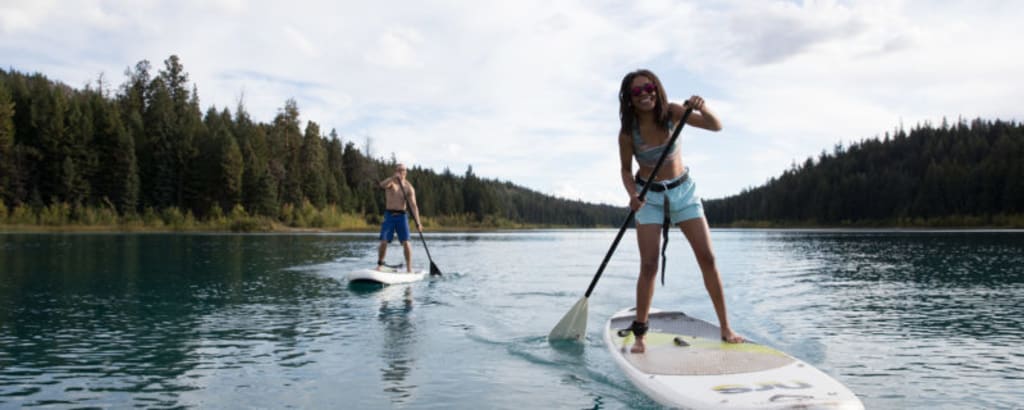Beginner’s Guide to Water Sports: Stand up Paddleboarding
Stand up Paddleboarding

Are you looking for a new workout? Perhaps it’s time to consider stand up paddleboarding. Ever increasing in popularity, this versatile board sport has a range of health benefits, both mental and physical. With so much to love about stand up paddleboarding, there must be some catch, right? Maybe it’s difficult… Well we wouldn’t say so. There are a few things you should know before your first SUP adventure though.
In this post, we’ll take a look at some of the most important things to know for beginner stand up paddleboarders. We’ll cover equipment, top tips, and some handy health benefits too. Ready? Let’s go!
Essential Equipment for stand up paddleboarding
Whether renting or buying your equipment, you can’t paddle without these four key pieces of equipment.
Board
The first thing you’re going to need is a board. Don’t just pick the cheapest or the most colourful one though! There is a science to choosing a board. You need to pick a board that corresponds with your weight and skill level. And it’s best to leave some flexibility on the weight limit, as you may bring a bag with you, or even your pet pooch.
Another choice to make is between a hard and inflatable paddle board. Inflatable boards are popular with all-round paddleboarders and yogis - and they have the handy advantage of being very easy to carry around.
Paddle
Just as important as the board is your paddle. If you’re looking to use your SUP for several different disciplines, such as surfing and yoga, it’s best to look at a height adjustable paddle. If you must buy a fixed length paddle, make sure it’s around 25 cm (6 - 8 inches) longer than your total height.
Paddles should cost about a quarter of the price of your board if buying. And if you’re looking for the lightest and most nimble paddles, take a look at fiberglass and carbon fiber options.
Personal Floatation Device
The board and paddle are essential for movement, but these two devices highlight safety. PFDs (also known as personal floatation devices) should be worn as a precaution to keep you safe if you fall in the water. Even if you’re a strong swimmer, cold waters could send you into shock.
You won’t even notice your PFD once paddling. You can even get compact PFDs which will fit around your waist.
Leash
A leash is another safety device that you shouldn’t paddle without. Again, you won’t notice this one until you fall off your board. It fits around your ankle and will keep you tethered to the board. Surfers may feel that this is familiar - but do note that SUP and surf leashes are different, and if you use the wrong type of leash, there is a possibility it will snap. SUP leashes are longer and thicker.
Top tips for beginner paddleboarders
Start in calm water
It’s not just paddleboarding where you should keep things simple at the beginning. Be sure to find somewhere calm, ideally with flat water. That could be your nearest lake or a lagoon at the coast. Standing on the board will take a bit of getting used to, so it’s best to have as little movement as possible to contend with from the water under the board.
Should you struggle to stand at first, get on your knees in the middle of the board. Move one foot forward at a time slowly, until you feel comfortable enough to start off.
At the beginning, you should make sure you have lots of space either side too. If you’re in a class, your instructor will make sure of it, but if learning yourself, leave at least a paddleboard’s distance between you and other learners!
Learn to take a fall
One of the reasons that you need to have plenty of space around you is that you may fall over. Don’t worry, it’s normal. You are trying a new sport after all! The most important thing to remember is that you should fall away from the board.
That way, you’ll drop into the water and your leash and PFD will ensure that your safe. This is preferable to hitting the board, as you could get a really nasty injury from hitting a hard board!
Know your limits
A top tip for new paddleboarders is not to try too much too soon. It’s not a race (at least not yet), so take your time in learning the basics and avoid any injury risk. When you start to get more comfortable with your paddleboard, you may even be able to enjoy other sports such as surfing, fishing, and yoga.
Health benefits of stand up paddleboarding
By now, you’ll probably be convinced that stand up paddleboarding is your new workout. However, if not, let us quickly give you some of the health benefits you can expect from the sport.
The first and most obvious is that it’s an excellent core workout. Many paddleboarders see more muscle tone on their abs in the weeks and months following their first SUP sessions. Working on the core also means that your balance and stability is improved too.
As well as all that, you can lose weight and improve your cardiovascular health - all with a fun and low impact sport. If all that isn’t enough, SUP also slows down your mind and allows you take in your beautiful, natural surroundings. That combined with the therapeutic health of water means that it can reduce stress and boost mental health too. It really is the perfect workout!






Comments
There are no comments for this story
Be the first to respond and start the conversation.